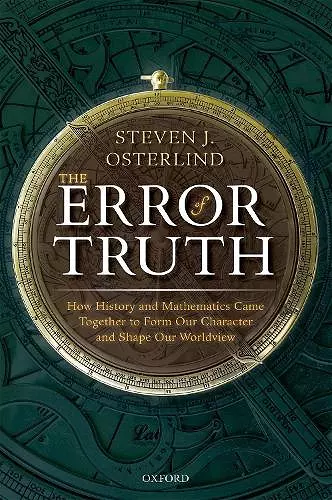The Error of Truth
How History and Mathematics Came Together to Form Our Character and Shape Our Worldview
Format:Hardback
Publisher:Oxford University Press
Published:7th Feb '19
Currently unavailable, and unfortunately no date known when it will be back

Quantitative thinking is our inclination to view natural and everyday phenomena through a lens of measurable events, with forecasts, odds, predictions, and likelihood playing a dominant part. The Error of Truth recounts the astonishing and unexpected tale of how quantitative thinking came to be, and its rise to primacy in the nineteenth and early twentieth centuries. Additionally, it considers how seeing the world through a quantitative lens has shaped our perception of the world we live in, and explores the lives of the individuals behind its early establishment. This worldview was unlike anything humankind had before, and it came about because of a momentous human achievement: we had learned how to measure uncertainty. Probability as a science was conceptualised. As a result of probability theory, we now had correlations, reliable predictions, regressions, the bellshaped curve for studying social phenomena, and the psychometrics of educational testing. Significantly, these developments happened during a relatively short period in world history— roughly, the 130-year period from 1790 to 1920, from about the close of the Napoleonic era, through the Enlightenment and the Industrial Revolutions, to the end of World War I. At which time, transportation had advanced rapidly, due to the invention of the steam engine, and literacy rates had increased exponentially. This brief period in time was ready for fresh intellectual activity, and it gave a kind of impetus for the probability inventions. Quantification is now everywhere in our daily lives, such as in the ubiquitous microchip in smartphones, cars, and appliances; in the Bayesian logic of artificial intelligence, as well as applications in business, engineering, medicine, economics, and elsewhere. Probability is the foundation of quantitative thinking. The Error of Truth tells its story— when, why, and how it happened.
The book is, in general, well-written, and the author writes in an accessible style, reflecting that the book is intended for a general audience with no, or little, previous knowledge of mathematics and probability theory...The book tells an important and interesting story with a good balance between sections that describe the general historical events from the considered period and parts that explain the mathematical accomplishments. * Jessica Carter, Metascience *
The book tells an important and interesting story with a good balance between sections that describe the general historical events from the considered period and parts that explain the mathematical accomplishments. Some of the sections explaining mathematical material, which fulfil the promise made in the Introduction of being written in plain English with mathematical content kept to a minimum, are illuminating. * Jessica Carter, Metascience *
...a fascinating story of how quantitative reasoning, especially probabilistic and statistical, was over a couple of hundred years taken up by more and more researchers and applied to an ever-increasing range of things which affect our lives — health care, insurance, urban planning, etc... * John Bayliss, The Mathematical Gazette *
This book is written in a colloquial style and presents the history of statistical science and many examples, which explain relevant developments of statistics. * Hans-Jurgen Schmidt, zbMath *
A revelatory history of how so much of humanity has come to internalize a quantified worldview. It's both thrilling and a little terrifying, all at once. * Duff McDonald, Journalist and author of the New York Times Best Seller The Firm: The Story of McKinsey and Its Secret Influence on American Business *
ISBN: 9780198831600
Dimensions: 241mm x 164mm x 25mm
Weight: 730g
352 pages